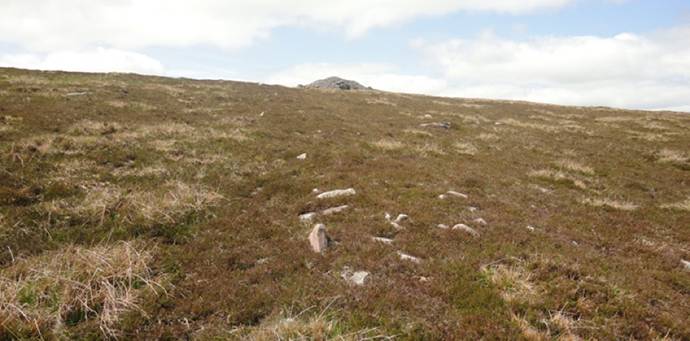Slievenamon cursus, Co. Tipperary
Cursus monuments consist of parallel banks of earth or stone, usually around 30m apart, which run for at least 100m, most examples being between 200m and 400m long. Some such monuments in England have been dated to the Neolithic period. In recent years work by Chris Corlett and Ivor Kenny have brought several previously unrecognised cursus monuments to light. Unlike many of the classic lowland English examples, these Leinster cursus monuments are on steep mountain sides. Following on from their work a cursus on the east slope of Slievenamon in Co. Tipperary has been identified.

This is the widest of the known cursus monuments, with a maximum width of 90m, though it narrows to 75m at its upper western end. The upper end of the cursus terminates with a straight bank. Terminating banks have been noted at some other examples, such as a recently identified cursus in Co. Kilkenny (KK005-004----) where the upper portion terminates in a curving bank. Curiously at Keadeen cursus, Co. Wicklow (WI027-089----), it is the lower end of the cursus which has a straight terminating bank.

Another feature which has been noted at many cursus monuments is their close association with hilltop cairns. On Slievenamon there is a cairn (TS078-001----) just east of the summit of the mountain and 150m west-north-west of the cursus. Another cairn (TS071-021----) is visible 1km to the north from the upper end of the cursus and an unclassified megalithic tomb (TS071-064----), though not visible, is located c. 930m to the north. The view north-east to south from the top of the cursus is extensive, with the passage tomb at Knockroe (KK034-019001-) c. 10km to the east and the passage tomb at Baunfree (KK034-031----) c. 13km to the south-east.

The Slievenamon cursus consists of two roughly parallel stone banks (N bank Wth 1.9m at top; overall Wth 3.3m; H 0.3m; S bank Wth 1.3m at top; overall Wth 2.2-2.9m; H 0.25-0.35m) overgrowth with grass, moss and heather. The terminating bank (Wth 2.7m at top; overall Wth 5.5m; int. H 1m; ext. H 0.22m) curves at the NW angle, while at the SW angle there is a gap (Wth 2.7m). The N bank runs E-W from the W end for 118m before turning ESE for the remaining c. 260m while the S bank runs ESE-WNW for its entire length of c. 360m. The upper end of the monument is on a relatively gentle slope, however, the ground level becomes increasingly steeper and both banks appear to terminate at the E end where the ground level becomes very steep. Similar cursus monuments have been identified in Carlow (CW020-026----; CW020-027----); Kilkenny (KK005-004----); Kildare (KD032-058----) and Wicklow (WI005-124----; WI027-089----) but overall these are rare monuments.


Because these monuments appear to have served no obvious practical purpose, and given their siting and association with cairns, it is presumed that they had a ceremonial function. When freshly constructed they must have looked quite striking in the landscape. Perhaps these monuments were symbols of tribal power as well as forming a physical structure for some long-forgotten ritual.
References
Corlett, C. 2014 Some cursus monuments in South Leinster. Archaeology Ireland 28 (2), 20-25.
Kenny, I. 2014 Another cursus comes to light. Archaeology Ireland 28 (3), 21-5.
